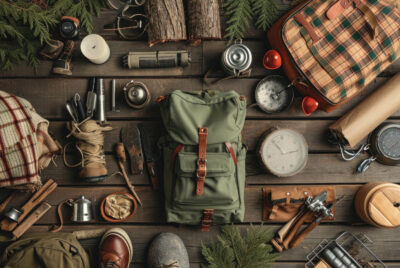Car Camping Essentials
Have you ever wanted to experience the great outdoors without giving up all the comforts of home? That’s where car camping comes in! Unlike traditional backpacking, car camping allows you to bring more gear, stay comfortable, and explore remote locations with ease. Whether you’re a weekend warrior or planning an extended road trip, this guide will break down everything you need to know about car camping essentials to make your adventure a success.
What Makes Car Camping Different?
Before diving into the car camping essentials you’ll need, let’s clarify what sets car camping apart from other outdoor adventures. Unlike backpacking, where every ounce matters, car camping gives you the luxury of space. You can bring that extra pillow, pack your favorite cast iron pan, and maybe even toss in a portable espresso maker without worrying about weight.
Car camping bridges the gap between roughing it in the wilderness and booking a cabin. You’ll still enjoy starry nights and morning birdsong, but with significantly more comfort than traditional camping allows. For families, first-time campers, or those who simply prefer not to sacrifice their creature comforts, car camping offers the perfect balance of adventure and convenience.
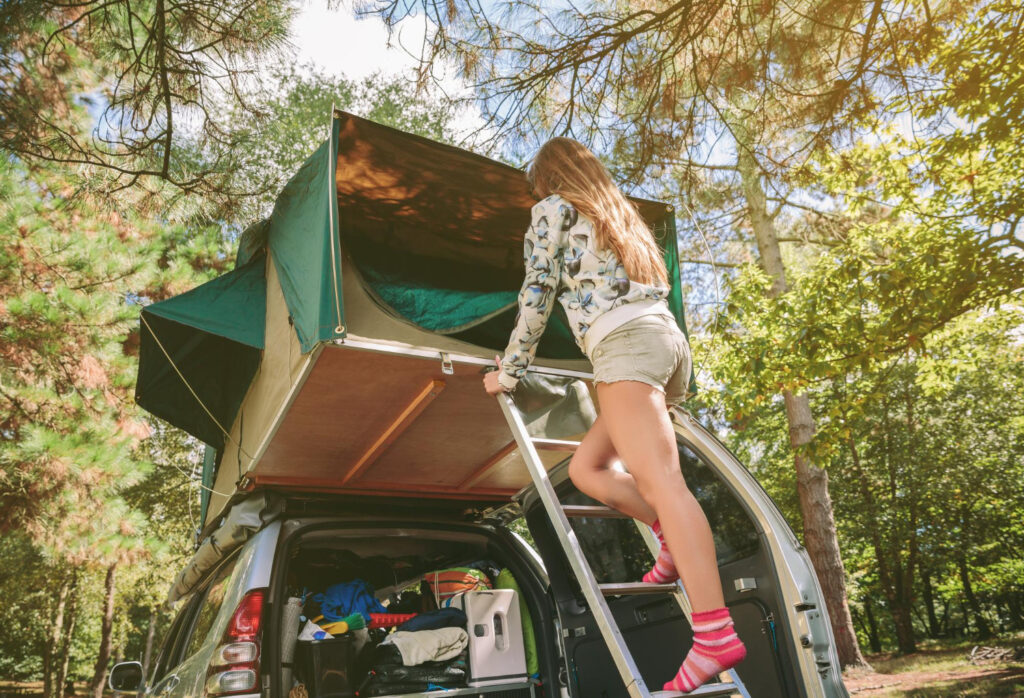
Choosing the Right Vehicle for Car Camping
Your vehicle choice can make or break your car camping experience. Not all cars are created equal when it comes to this unique style of adventure.
What Makes a Vehicle Suitable for Car Camping?
When selecting your car camping chariot, consider these key features:
Flat, foldable seats create a comfortable sleeping platform when needed. This versatility allows you to sleep inside during bad weather or in areas where tent camping isn’t practical.
Ample storage space ensures you can bring all your car camping essentials without cramming gear into every nook and cranny. Remember, one of the joys of car camping is not having to pare down your packing list to the absolute minimum.
Good fuel efficiency matters, especially for longer trips where you’ll be covering significant distances. Better mileage means more adventure and less money spent at the pump.
Off-road capabilities open up remote destinations that standard vehicles can’t reach. While not absolutely necessary, having a vehicle with decent ground clearance and possibly four-wheel drive expands your camping horizons dramatically.
Best Types of Vehicles for Car Camping
SUVs with fold-flat seats offer the ideal combination of sleeping space and storage have become favorites in the car camping community for their versatility.
Minivans might not seem adventurous, but their spacious interiors make them perfect for car camping. With seats removed or folded, they transform into cozy mobile bedrooms with plenty of headroom.
Pickup trucks paired with camper shells create a secure, weather-protected sleeping area while maintaining the truck’s off-road capabilities. The separate bed and cab also allow for better organization of gear.
Station wagons blend car-like efficiency with surprising amounts of space. Vehicles like the Subaru Outback have developed cult followings among car campers for their perfect balance of economy, capability, and comfort.
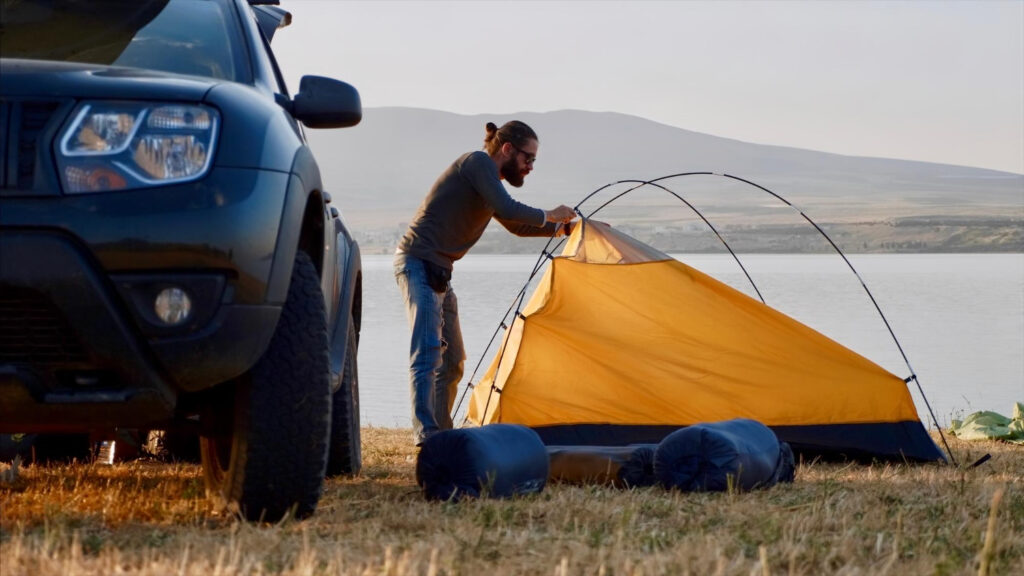
Essential Shelter & Sleeping Setup
After a day of exploration, nothing matters more than getting a good night’s rest. Your sleeping setup is perhaps the most important of all car camping essentials.
Sleeping Options for Car Camping
Inside the car sleeping is often the simplest approach. With seats folded down, an inflatable mattress, foam pad, or purpose-built car mattress can transform your vehicle into a cozy bedroom. This option shines during inclement weather and provides added security in unfamiliar areas.
Rooftop tents have revolutionized car camping in recent years. These fold-out shelters mount to your roof rack and typically include a built-in mattress. The elevated position keeps you away from rocky ground, potential flooding, and curious wildlife. Setup takes just minutes – simply unfold and extend the ladder.
Ground tents still have their place in car camping. They offer more living space than sleeping in your vehicle and allow you to leave your campsite set up while taking your car on day trips. Consider a larger tent than you’d use for backpacking – the extra space is worth it when you don’t have to carry it on your back.
Creating Comfort: Sleeping Gear
Whatever shelter option you choose, investing in quality sleeping gear makes all the difference. Temperature-appropriate sleeping bags remain essential car camping items, even if you’re not backpacking. For couples, consider a double sleeping bag for extra coziness.
Sleeping pads or mattresses provide crucial insulation from the cold ground or vehicle floor. Self-inflating pads offer a good balance of comfort and convenience, while air mattresses provide home-like comfort but require a pump.
Pillows are a car camping luxury you shouldn’t skip. While backpackers might use bundled clothes as makeshift pillows, car campers can bring the real thing. Your neck will thank you in the morning.
Privacy & Window Coverings
Privacy transforms your vehicle from transportation to accommodation. Consider these options:
DIY window covers made from Reflectix (that silver bubble-wrap insulation) serve double duty by providing privacy and insulation. Cut to fit each window, they can be held in place with suction cups or simply wedged into the window frame.
Blackout curtains or purpose-made vehicle curtains create a homey atmosphere while blocking light pollution that might disrupt your sleep. Some clever car campers install tension rods and lightweight curtains for a quick, removable solution.
Bug nets for windows allow you to enjoy fresh air without unwelcome visitors. Look for magnetic versions that create a tight seal but allow easy entry and exit.
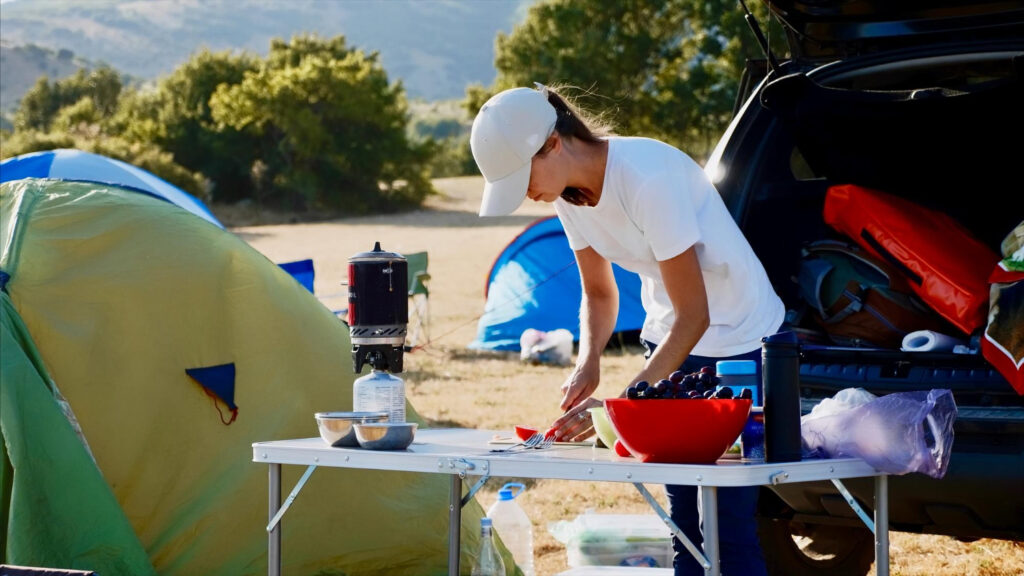
Car Camping Essentials for Cooking and Eating
One of the greatest joys of car camping is the ability to prepare delicious meals without ultra-lightweight constraints. Your car camping kitchen can be as simple or elaborate as you prefer.
Choosing the Right Camping Stove
Propane stoves remain the gold standard for car camping due to their reliability and ease of use. Two-burner models like the Coleman Classic or Camp Chef Everest give you enough cooking surface to prepare complete meals.
Butane stoves pack down smaller and work well for quick meals. They’re especially popular for morning coffee and simple dinners but may struggle in very cold conditions.
Multi-fuel stoves prove valuable for extended trips or international travel where specific fuel types might be hard to find. Though more complex to operate, their versatility is unmatched.
Cooking Essentials
A cast-iron skillet or non-stick pan opens up endless meal possibilities. Cast iron in particular excels at campfire cooking, though it adds significant weight.
A lightweight cookware set with pots of different sizes accommodates everything from boiling water to simmering stews. Look for nesting sets that save space.
A collapsible sink simplifies dishwashing and helps you practice Leave No Trace principles by properly disposing of graywater.
A portable cutting board and quality knife make food prep much easier than trying to chop vegetables on available surfaces or with a pocket knife.
Camp Kitchen Organization
Organization makes cooking at your campsite more enjoyable. Consider these car camping essentials:
A camp kitchen box or chuck box keeps cooking supplies together and easily accessible. Commercial options are available, but many experienced car campers create custom solutions from plastic totes or wooden boxes.
Collapsible items save valuable space – look for folding bowls, collapsible colanders, and stackable measuring cups.
Reusable ziplock bags or small containers help organize spices and other ingredients, eliminating the need to bring entire containers of rarely-used seasonings.
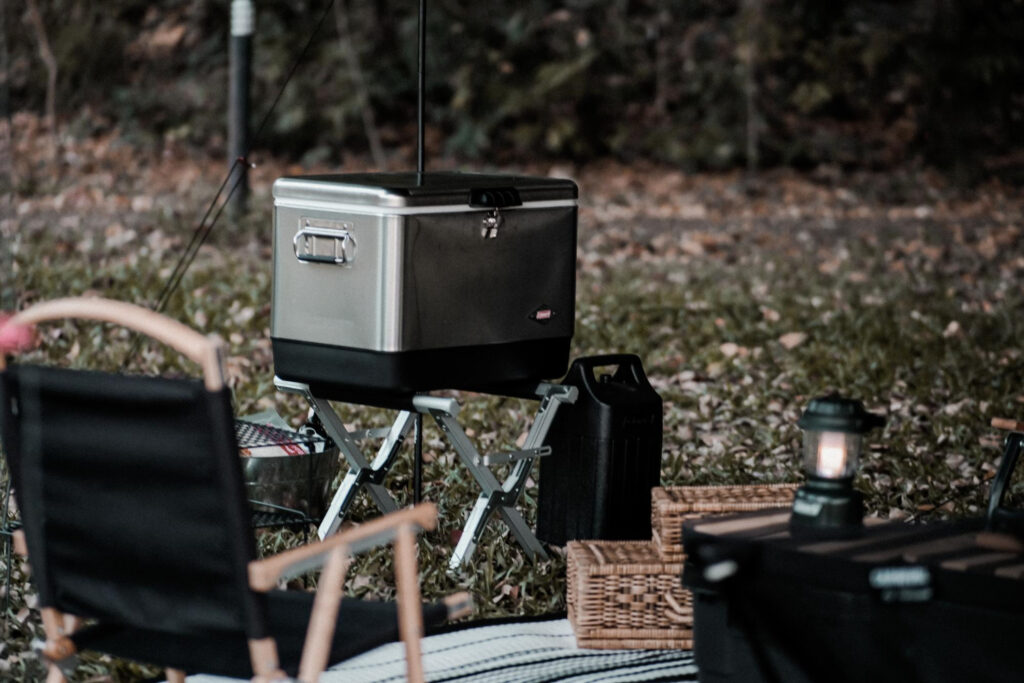
Keeping Food & Drinks Fresh
Food storage represents one of the biggest differences between car camping and backpacking. With a vehicle at your disposal, you can enjoy fresh food throughout your trip.
Cooler vs. Portable Fridge
A high-quality cooler remains affordable and effective for trips up to a week. Pre-chill the cooler before packing, use block ice instead of cubes when possible, and keep it in the shade to maximize ice retention.
A portable fridge/freezer powered by your vehicle’s electrical system or a portable power station eliminates the need for ice, creates more usable space, and keeps food at consistent temperatures. Though the upfront investment is substantial, many dedicated car campers consider these fridges essential items that quickly pay for themselves in convenience and reduced food waste.
Storing Food Safely
Bear-proof containers become mandatory in many camping areas throughout North America. Even in regions without bears, proper food storage prevents issues with raccoons, squirrels, and other wildlife.
Separate coolers for beverages and perishable foods prevent frequent opening from warming sensitive items like meat and dairy. Your drink cooler will be opened much more frequently than your food cooler.
Dry food storage boxes protect non-refrigerated items from humidity, pests, and accidental crushing. Clear plastic bins allow you to see contents without unpacking everything.
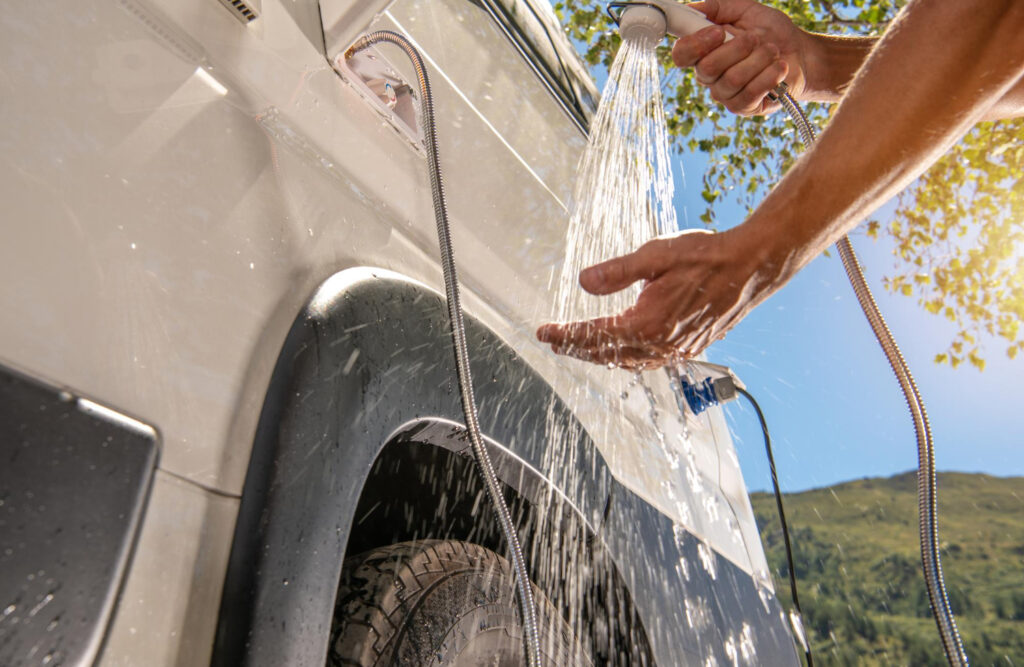
Staying Clean & Hygienic
Extended time outdoors doesn’t mean surrendering cleanliness. Car camping allows you to bring supplies that keep you feeling fresh and comfortable.
Portable Shower & Hygiene Tips
Solar showers have become essential car camping gear for many outdoor enthusiasts. These black bags or pouches heat water using sunlight, then provide gravity-fed showers. Hang them from your vehicle’s roof rack or a sturdy tree branch for a refreshing rinse.
Biodegradable wipes offer quick cleanup when shower facilities aren’t available. Look for compostable options that minimize environmental impact.
Dry shampoo extends the time between proper showers while keeping your hair looking and feeling clean.
A privacy tent or shower tent provides a changing room and shower enclosure when needed. These lightweight structures set up quickly and pack down small.
Managing Waste & Garbage
Always follow Leave No Trace principles by packing out everything you bring in. A designated waste management system prevents your campsite from becoming cluttered and protects wildlife.
A collapsible trash bin with a secure lid keeps odors contained and prevents wildlife from being attracted to your site. Some car campers repurpose pop-up laundry hampers with trash bags for this purpose.
Separate containers for recycling and compost (if you’ll be able to dispose of it properly) make end-of-trip cleanup more efficient and environmentally friendly.
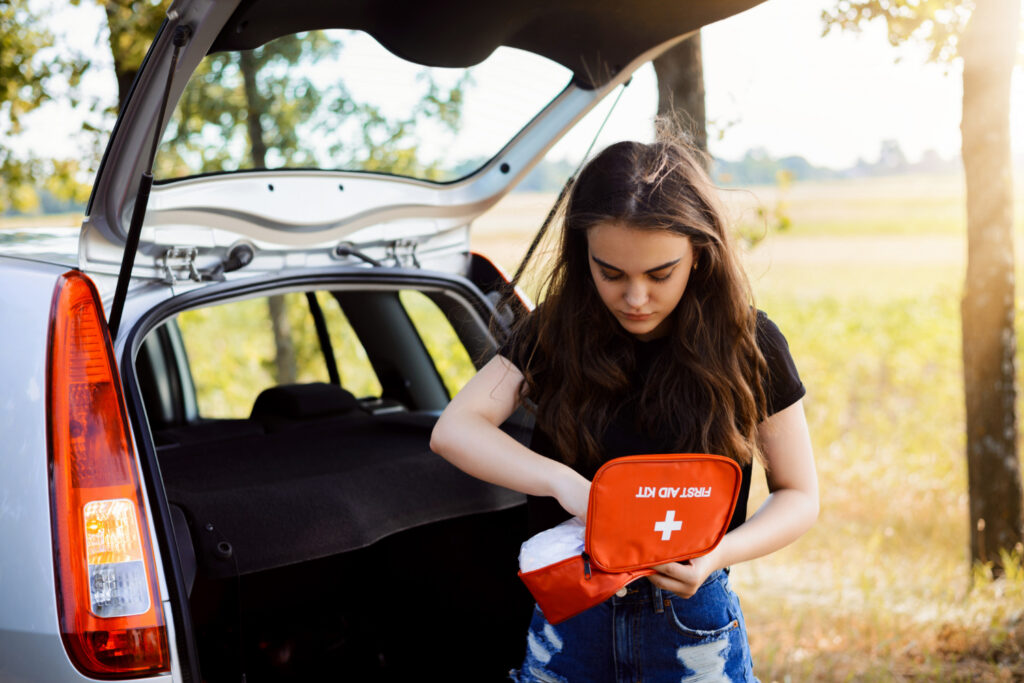
Safety & Emergency Preparedness
The self-sufficient nature of car camping makes emergency preparedness even more important, especially when visiting remote areas.
First Aid Kit & Emergency Tools
A comprehensive first aid kit should contain bandages, antiseptics, pain relievers, and any personal medications. Consider adding items specific to your destination – snake bite kits for desert camping, for instance.
Multi-tools, flashlights, and emergency whistles should be accessible, not buried under gear. Consider keeping a separate emergency kit in an easily reached location.
Vehicle recovery gear becomes essential for off-road car camping. Items like traction boards, a shovel, and a portable air compressor can prevent a minor situation from becoming a major emergency.
Navigation & Communication
GPS apps like Gaia GPS or Google Maps Offline provide detailed mapping even without cell service. Download maps before leaving cellular coverage areas.
A satellite communicator offers peace of mind for remote adventures. Devices like the Garmin inReach or SPOT allow text communication and emergency signalling from almost anywhere on earth.
Paper maps and a compass provide reliable backup when technology fails. Mark your campsites and important landmarks as you travel.
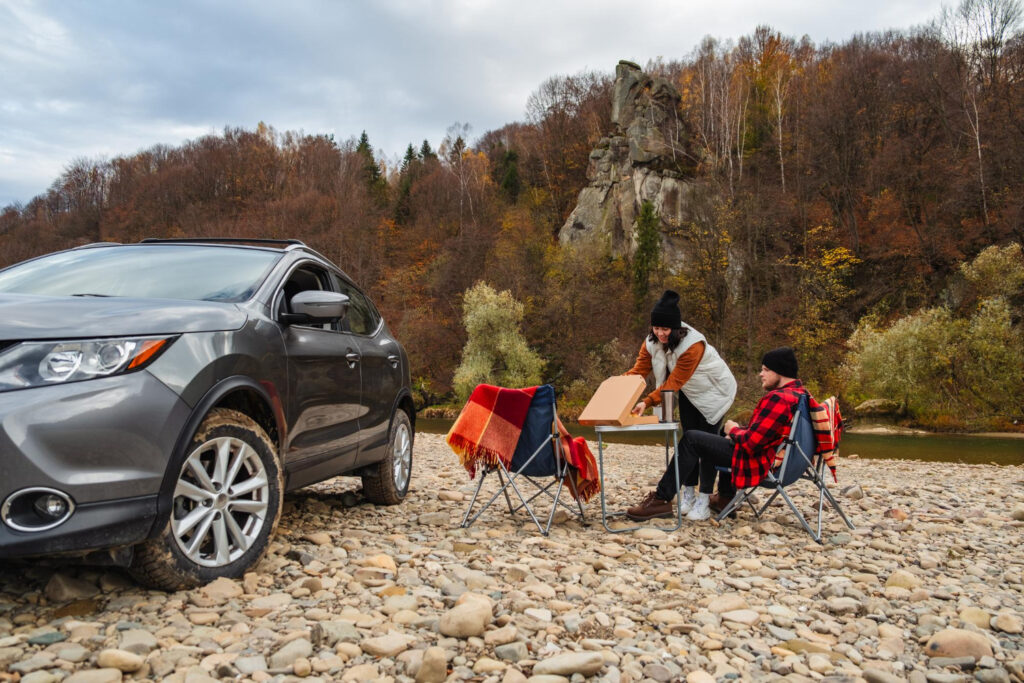
Additional Car Camping Essentials for Comfort and Convenience
Beyond the basics, these items enhance the car camping experience:
Portable power stations or solar generators keep devices charged and run small appliances. Modern options can power everything from string lights to laptop computers.
Camp furniture transforms a parking spot into a home away from home. Lightweight chairs, a folding table, and perhaps a hammock make relaxation time more enjoyable.
Lighting options like headlamps, lanterns, and string lights extend your activities beyond daylight hours and create ambiance at your campsite.
Planning Your Car Camping Adventure
With your car camping essentials packed and ready, consider these final planning tips:
Research your destination thoroughly, focusing on regulations, permits, and seasonal considerations. Some popular car camping areas require reservations months in advance.
Plan your route with fuel stops in mind, especially in remote areas where gas stations may be limited. Always carry extra fuel if you’ll be exploring far from services.
Share your itinerary with someone reliable who isn’t joining the trip. Include expected return dates and check-in plans.
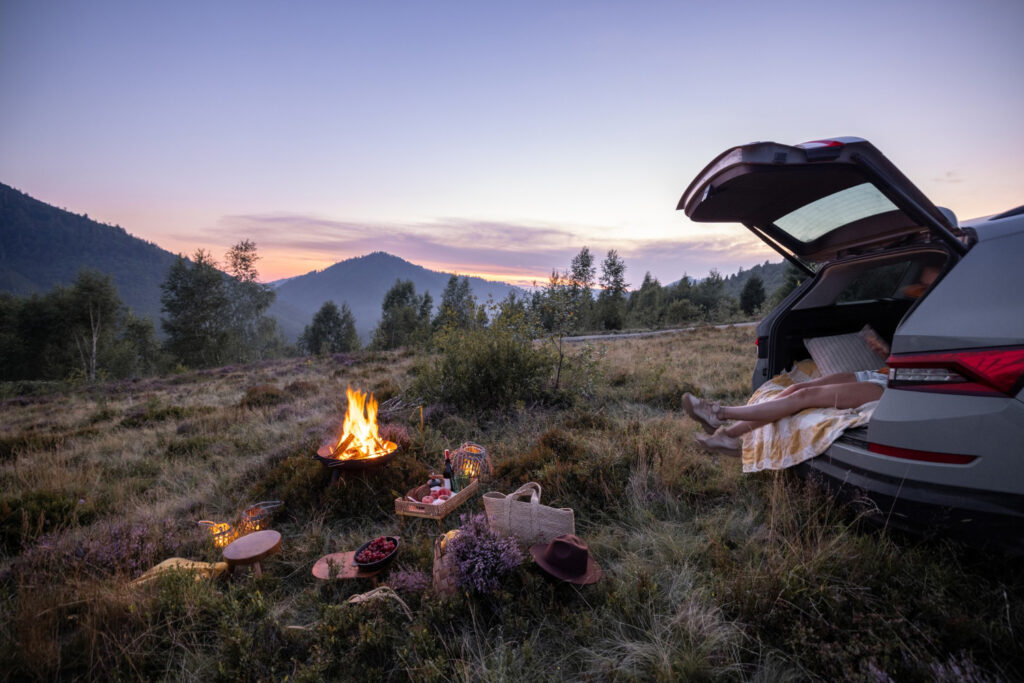
Conclusion
Car camping offers an accessible entry point to outdoor adventure without sacrificing comfort. By assembling the right car camping essentials – from your sleeping setup to cooking gear and safety equipment – you’ll be prepared for memorable journeys wherever your wheels take you.
Whether you’re escaping for a weekend or embarking on an extended road trip, car camping connects you with natural settings while maintaining a level of comfort that makes the experience enjoyable for adventurers of all experience levels. The freedom to bring more than just the bare necessities transforms ordinary camping into an extraordinary escape from everyday life.
So pack your car camping essentials, hit the road, and discover the perfect balance between adventure and comfort that only car camping can provide!
FAQs About Car Camping Essentials
1. What is the best car for camping?
An SUV or minivan with foldable seats offers the best combination of space and comfort.
2. How do I keep my car warm at night while camping?
Use insulated sleeping bags rated for lower temperatures than you expect, portable heaters (with proper safety measures and ventilation), window insulation, and extra blankets. Some campers use hot water bottles placed in sleeping bags before turning in.
3. Can I car camp anywhere?
Check local laws and regulations; many national forests and Bureau of Land Management (BLM) lands allow dispersed camping, often for free. Apps like iOverlander and Campendium help locate legal camping areas. Always respect private property and posted restrictions.
4. What are some easy meal ideas for car camping?
Wraps, pasta dishes, grilled cheese sandwiches, pre-marinated meats, foil packet meals, and one-pot stews work beautifully for car camping. Prepare ingredients at home to simplify campsite cooking.
5. How do I find the best car camping spots?
Apps like iOverlander, Campendium, and The Dyrt help locate established and dispersed camping areas. National forest and BLM websites often list official campgrounds. Local outdoor stores can provide valuable information about lesser-known spots.




